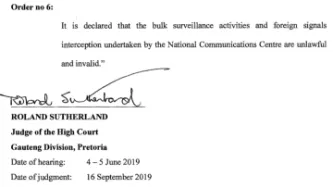The Trap of Simplicity: Why Analogies for Surveillance Fail Us

Bad analogies about surveillance technology pervade newspaper reports, politicians’ speeches, and legal arguments. While it’s natural to want simple explanations to understand complex technology, it does us a disservice when governments, the media, or the courts mislead us through analogies that are inadequate. It is even worse if these analogies are used as a basis for policy change.
Privacy International’s legal challenge against GCHQ’s mass surveillance rests on the capability of the judges of the Investigatory Powers Tribunal – the only place where complaints against intelligence agencies can be heard – to understand communications infrastructure and how intelligence agencies exploit it. If these criteria are obfuscated by analogies, lawmakers will be sent down a terrible path of misinterpretation for years to come.
An effective analogy helps assess modern practices by weighing relevant legal frames. For example, by analogising tracking devices to binoculars or telephone wiretapping to listening at a door, courts focus on a shared function of the technologies that is readily understood. Tracking devices, like binoculars, can augment visual surveillance. Wiretapping, like listening at a door, allows law enforcement to capture conversations outside of the house. Courts are then spared from deliberating on complex technical details and can apply the relevant statute.
But these details should not be obscured. Tracking devices can locate the target prior to visual surveillance or replace it altogether. Wiretapping has reduced cost barriers, a high potential for pervasiveness and a quality of evidence far exceeding that of the imperfect human memory.
While the benefits of analogies are important, the chilling effects they have are not as simply measured. Judgements influence social norms and shape the law’s development in sometimes unpredictable ways.
Setting the stage for insufficient analogies
In R v. Tessling (2004), the Supreme Court of Canada ruled that a homeowner’s right to be free from unreasonable search and seizure was not violated when police inspected his house with a thermal imaging camera. To the court, the heat was a “voluntary exposure of information” since it could be seen on external surfaces by the naked eye.
The Court in Tessling specifically intended to avoid a broad ruling, but to no avail. Courts later extended Tesslingby analogy following a shallow logic: like in Tessling, the external pattern of [X] on the external surface of [Y] is not protected. A common court analogy is likening heat to odour [X] and the surface of personal effects to the surface of a house [Y]. By doing so, many courts1 justified the use of detection dogs. Applying Tessling by analogy will become increasingly problematic as body-scanning technologies improve.
In Kyllo v United States (2001), the Supreme Court of the United States found that the use of a thermal imaging camera was a search. The majority emphasised that the Court needed to take “the long view” in interpreting the Fourth Amendment and that a “mechanical interpretation” leaves homeowners “at the mercy of advancing technology”. Like in Kyllo, courts must recognise that there is a risk of broad interpretation by analogy if they rely on a distinction -- such as if the information within a property was collected internally or externally– that will soon become obsolete with technology.
Despite the diverging rulings of Kyllo and Tessling, the legal protection of the home informed both opinions. This categorisation allowed the courts to consider traditional property law in determining privacy interests. However, as Internet communications eliminated the need for physical property trespass and conflated previously siloed conceptualisations of privacy, much legal ambiguity arose and as expected, analogies did as well.
Analogies in the digital world
As courts grapple to apply the substance of rules developed hundreds of years ago to modern practices, certain distinctions must be recognised. Digital packets should not be analogised to postage letters. Unlike letters, packets travel on a best efforts basis that causes them to travel through multiple countries even when the parties are in geographic proximity. Packets can also describe the nature of the transmitted request – if it is an email, file, instant message or video. While the inside and outside of letters happen to be correspondent to content and non-content respectively, such a clear categorisation is incompatible with packets.
Consider sent emails: the email header – the ‘metadata’– contains information that is distinct from the information on an envelope. The sender’s IP for instance may provide many specific locations over time from where messages are sent, not simply a static home address chosen by the sender.
But it is not only the substance of each piece of information that is concerning. When disparate pieces of information such as those acquired from metadata are connected, a detailed profile of an individual can be created. This capacity to multiplying the force of less protected information through mass aggregation is new.
Analogising password protected digital storage to a locked box ignores that unlike a physical lock, passwords are not always visible. Law enforcement could not automatically circumvent the protections of physical objects. Similarly, analogies between laptops and containers neglect that past laws were crafted when physical space provided an upper limit for information capable of being stored.
There is a clear trend in the discourse surrounding surveillance: new technologies are analogised to a less powerful, pervasive and intrusive technology by only considering a single common function. This narrow logic strips the technology of important capabilities and novel contexts in which it can be used. It is not that analogies are inherently problematic, but rather significant problems arise when they are used by courts to only focus on a single dimension of the technology.
Such analogies generate a cursory understanding and subsequently, courts ignore areas of warranted concern. As a recent encouraging US Supreme Court opinion puts it in perhaps the most appropriate use of an analogy, likening a search of a cell phone to a container “is like saying a ride on horseback is materially indistinguishable from a flight to the moon. Both are ways of getting from point A to point B, but little else justifies lumping them together.”
Technologies can now collect vast amounts internet communications and access the most intimate details of our personal lives with ease. Powerful computers can sift through large troves of data, make connections between multiple sources of information and reach far back into the past with retention systems.
We are living in a time of new surveillance capabilities. To best protect our threatened rights it is worthwhile to resist the allure of insufficient analogies.



